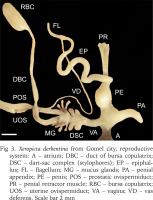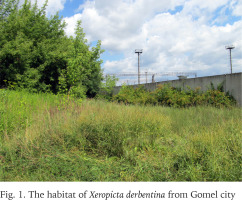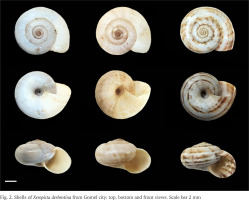INTRODUCTION
Human activity and global climate changes have contributed to the spread of several species of terrestrial molluscs in Belarus, which has become especially noticeable at the turn of the 20th and 21st centuries (Zemoglyadchuk 2020). Among them, a special place is occupied by species well adapted to inhabit open xerothermic biotopes: Xerolenta obvia (Menke, 1828), Monacha cartusiana (O. F. Müller, 1774), Brephulopsis cylindrica (Menke, 1828). Currently, Xerolenta obvia occurs in central and southern parts of country, occupying mainly urban habitats. In Belarus, populations of this species have been recorded in Brest, Baranovichi, Grodno and Gomel (Zemoglyadchuk 2020, Ostrovsky 2021). Two other xerophilous species of land snails, Brephulopsis cylindrica and Monacha cartusiana, has so far managed to form colonies only in the south-west of Belarus – in Brest city (Rabchuk & Zemoglyadchuk 2011, Zemoglyadchuk 2020). One other recently discovered species, Xeropicta derbentina (Krynicki, 1836), is reported in this paper.
MATERIAL AND METHODS
Material was collected in a dry xerophytic meadow along the railway track near micro-district “Sputnik Mira” in Gomel city (52°26'26"N, 30°57'07"E, 139 a.s.l.) (Fig. 1). The first specimen of X. derbentina was found here on 21.07.2022, another 2 living specimens and 1 empty shell was collected on 02.10.2022. The snails were killed in water and then fixed in 75%-ethanol. The determination was carried out using the monographs of Balashov (2016) and Schileyko (1978). The material is deposited in the author’s private collection.
RESULTS
Description: Shell (Fig. 2) more or less depressed, opaque, moderately solid, of 5–5.5 somewhat convex whorls. Last whorl straight, evenly rounded at periphery. Colour uniformly white or with brown spiral bands, which can break up into a series of spots. Embryonic whorls smooth. Post-nuclear sculpture of weak, irregular radial wrinkles. Aperture more or less rounded, slightly oblique, with simple margins; lip, when present, weak. The umbilicus funnel-like and narrow. Width of shell of adult specimens ranges between 14–18 mm, and height between 8–10 mm.
The reproductive anatomy (Fig. 3) clearly corresponds to existing descriptions of X. derbentina (Schileyko 1978, Balashov 2016). Flagellum about 4 times shorter than epiphallus. Epiphallus often twisted. Penis roughly fusiform, with verge. Inner canal of verge hung from one or two straps; thus, the intravergic cavity may be paired, but fused with circular cavity lying in the lower part of the epiphallus. Penial retractor attached to the penis-epiphallus junction. Lower part of penis with conic appendix; internally appendix with a very strong axial pilaster. Free oviduct 2–3 times shorter than vagina. Lower and upper pairs of dart sacs (stylophores) of about equal size; lower stylophores contain darts while upper ones are empty. Mucus glands 4, each with 2–3 arms. Spermathecal stalk subcylindrical, reservoir adhering to upper half of spermoviduct. The distinguishing features of X. derbentina distal genitalia are shown in Fig. 3.
Fig 3
Xeropicta derbentina from Gomel city, reproductive system: A – atrium; DBC – duct of bursa copulatrix; DSC – dart-sac complex (stylophores); EP – epiphallus; FL – flagellum; MG – mucus glands; PA – penial appendix; PE – penis; POS – prostatic ovispermiduct; PR – penial retractor muscle; RBC – bursa copulatrix; UOS – uterine ovispermiduct; VA – vagina; VD – vas deferens. Scale bar 2 mm

Xeropicta derbentina is conchologically similar to Xerolenta obvia, more widely distributed in Belarus, but anatomically these species of terrestrial molluscs can be easily distinguished by the number of stylophores: four (two pairs) in X. derbentina and two (one pair) in Xerolenta obvia. In addition, the stylophores of Xerolenta obvia are massive, with a characteristic swelling at the base.
To differentiate X. derbentina and the very close species X. krynickii (Krynicki, 1833), which is native to steppes of the Crimean peninsula and Northern Black Sea region (Gural-Sverlova & Gural 2017), the relative length of the flagellum is used, which in X. derbentina is about 1/4, and in X. krynickii – from 1/3 to 1/2 the length of the epiphallus. These two species also differ conchologically: between 1 and 1.5 whorls are visible within the umbilicus of X. derbentina, but no more than 0.5 in X. krynickii.
DISCUSSION
The terrestrial snail Xeropicta derbentina has been known for a long time around the Eastern Mediterranean, the Caucasus, Anatolia and southern coast of Crimea (Pusanov 1925, 1927, Schileyko 1978). X. derbentina is one of the most widespread species of southern Turkey and Georgia (Schütt 2001, 2010). However, during the last 75 years, the species has been found outside this range, indicating its invasive potential following passive dispersal. Records of this species in Western Europe are known as early as the middle of the twentieth century, for example, in France (Van Regteren Altena 1960), where the species has successfully adapted to their new habitats and formed established populations (Aubry et al. 2005, Kiss et al. 2005, Bartolucci & Bertrand 2022).
However, the first records of X. derbentina in southern Ukraine outside the Crimean peninsula were made only in the 1990s (Gural-Sverlova & Gural 2017). There are also no paleontological data on the presence of X. derbentina shells in the Pleistocene deposits of Ukraine (Kunitsa 1974). Thus, the widespread distribution of X. derbentina in the steppe zone of Ukraine, observed now, is clearly the result of anthropochory.
During the last decade, there have been many new records of X. derbentina across Ukraine, including Transcarpathia (Gural-Sverlova & Gural 2017, Balashov et al. 2018). Since 2014, a population of this species has been known in southwestern Russia (Adamova et al. 2019). Currently, X. derbentina has also been found in Italy (De Mattia 2007, De Mattia & Pešić 2014) and Moldova (Sysoev & Schileyko 2009, Welter-Schultes 2012).
In its native ranges, the species inhabits open steppe areas where its populations are numerous. X. derbentina is a typical xerophilous species having various adaptations to arid environments (Di Lellis et al. 2012, Troschinski et al. 2014, Dieterich et al. 2015, Kramarenko 2016). Studies of dispersal and locomotor activity of X. derbentina indicate its ability for successful invasion, aided by attachment to vehicles or livestock (Popov & Kramarenko 2004, Aubry et al. 2006).
CONCLUSIONS
A land snail species X. derbentina and genus Xeropicta Monterosato, 1892 from the family Geomitridae is described for the fauna of Belarus for the first time. This occurrence of X. derbentina in Belarus should be monitored in subsequent years. However, this new finding of X. derbentina in Gomel city (South-Eastern Belarus) much expands its known range to the north and documents its further spreading outside the natural range. It is likely that the spread of this species is accidental importing by railway transport. This assumption is fully consistent with the results of research by Ukrainian specialists (Balashov & Baidashnikov 2012, Gural-Sverlova & Gural 2017). Thus, further invasion of X. derbentina can be promoted by railway and automobile connections, as well as by the ecological features of the species, which prefers open dry biotopes with low vegetation and often settles along roads and in other anthropogenic habitats.



